|
|
|
Sort Order |
|
|
|
Items / Page
|
|
|
|
|
|
|
| Srl | Item |
| 1 |
ID:
106614


|
|
|
|
|
| Publication |
2011.
|
| Summary/Abstract |
Al Qaeda has developed a coherent strategy for insurgent violence that has much in common with the focoism advocated by Che Guevara in the 1960s. In their strategic writing, explored here, key Islamist strategists stress the role of violence in creating revolution, and describe the export of committed fighters to focoist enclaves at the margins of enemy control. In contrast to some prominent themes in recent scholarship, the article argues that physical space is demonstrably important to the revolutionaries, that their development of leaderless jihad is designed to supplement not replace territorial control, and that their violence is avowedly strategic.
|
|
|
|
|
|
|
|
|
|
|
|
|
|
|
|
| 2 |
ID:
169324
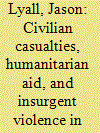

|
|
|
|
|
| Summary/Abstract |
Indiscriminate violence against civilians has long been viewed as a catalyst for new rounds of violence in civil wars. Can humanitarian assistance reduce violence after civilians have been harmed? Crossnational studies are pessimistic, drawing a connection between humanitarian aid and increased civil war violence, lethality, and duration. To date, however, we have few subnational studies of wartime aid and subsequent violence. To examine this relationship, I draw on the Afghan Civilian Assistance Program (ACAP II), a USAID-funded initiative that investigated 1,061 civilian casualty incidents (2011–13). Aid was assigned as if randomly to about half (55.8%) of these incidents, facilitating counterfactual estimation of how assistance affected Taliban attacks against the International Security Assistance Force, Afghan forces, and civilians. Challenging prior studies, I find that ACAP was associated with an average 23 percent reduction in attacks against ISAF, but not Afghan forces or civilians, at the village level for up to two years after the initial incident.
|
|
|
|
|
|
|
|
|
|
|
|
|
|
|
|
| 3 |
ID:
160567
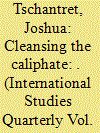

|
|
|
|
|
| Summary/Abstract |
Why do insurgents target certain groups for extermination? Despite a great deal of attention to the targeting of civilian ethnic minorities, comparatively little scholarship exists on insurgent violence against sexual minorities (lesbian, gay, bisexual, or transsexual individuals). This article maintains that the decision to target sexual minorities follows three distinct logics: two strategic and one ideological. First, insurgents face an incentive to outbid rivals by targeting sexual minorities when homophobic violence is politically and socially legitimated. Second, territorial control creates an incentive for insurgents to signal their ability to selectively punish, which they can accomplish through homophobic violence. Third, revolutionary ideologies provide legitimation for exclusionary violence in the pursuit of transforming society. Statistical analysis of insurgent violence against sexual minorities from 1985 to 2015 lends strong support for these arguments. Process tracing of the spread of violence against sexual minorities in Iraq and Syria clarifies the strategic causal mechanisms. When progovernment militias targeted perceived homosexuals with impunity, antigay violence was adopted by insurgent groups seeking to legitimize their claims to power; violence then quickly spread to competing insurgents. Two additional cases from Latin America demonstrate that ideology plays an important role in influencing which groups embrace homophobic violence even under these strategic constraints.
|
|
|
|
|
|
|
|
|
|
|
|
|
|
|
|
| 4 |
ID:
107799
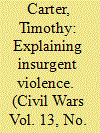

|
|
|
|
|
| Publication |
2011.
|
| Summary/Abstract |
The ongoing war in Afghanistan presents many questions for both scholars and policymakers. In particular, understanding insurgent military behavior generates considerable interest. Using a newly assembled daily, province-level data set, I begin to study the violence, focusing on the timing of US and allied fatalities in the war. I evaluate arguments commonly made about those elements favoring insurgent military success, proximity to resupply and difficult terrain, and find strong evidence supporting the first but less supporting the second as determinants of coalition fatalities. In addition, I find significant evidence linking factors unexamined in most civil war research, such as religious observance (the month of Ramadan) and warm weather, to these fatal events.
|
|
|
|
|
|
|
|
|
|
|
|
|
|
|
|
| 5 |
ID:
139796


|
|
|
|
|
| Summary/Abstract |
Does improved communication provided by modern cellphone technology affect the rise or fall of violence during insurgencies? A priori predictions are ambiguous; introducing cellphones can enhance insurgent communications but can also make it easier for the population to share information with counterinsurgents and creates opportunities for signals intelligence collection. We provide the first systematic micro-level test of the effect of cellphone communication on conflict using data on Iraq's cellphone network (2004–2009) and event data on violence. We show that increased mobile communications reduced insurgent violence in Iraq, both at the district level and for specific local coverage areas. The results provide support for models of insurgency that focus on noncombatants providing information as the key constraint on violent groups and highlight the fact that small changes in the transaction costs of cooperating with the government can have large macro effects on conflict.
|
|
|
|
|
|
|
|
|
|
|
|
|
|
|
|
| 6 |
ID:
163137
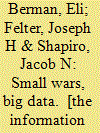

|
|
|
|
|
| Publication |
Princeton, Princeton University Press, 2018.
|
| Description |
xxi, 386p.hbk
|
| Standard Number |
9780691177076
|
|
|
|
|
|
|
|
|
|
|
|
Copies: C:1/I:0,R:0,Q:0
Circulation
| Accession# | Call# | Current Location | Status | Policy | Location |
| 059568 | 355.343/BER 059568 | Main | On Shelf | General | |
|
|
|
|
| 7 |
ID:
123503
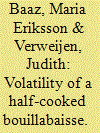

|
|
|
|
|
| Publication |
2013.
|
| Summary/Abstract |
In early 2012, Congolese army deserters formed the M23 rebel movement. This article analyses the insurgency and other armed group activity in the eastern DRC in the light of the politics of rebel-military integration. It argues that military integration processes have fuelled militarization in three main ways. First, by creating incentive structures promoting army desertion and insurgent violence; second, by fuelling inter- and intra-community conflicts; and third, by the further unmaking of an already unmade army. We argue that this is not merely the product of a 'lack of political will' on behalf of the DRC government, but must be understood in the light of the intricacies of Big Man politics and Kinshasa's weak grip over both the fragmented political-military landscape in the east and its own coercive arm. Demonstrating the link between military integration and militarization, the article concludes that these problems arise from the context and implementation of integration, rather than from the principle of military power sharing itself. It thus highlights the crucial agency of political-military entrepreneurs, as shaped by national-level policies, in the production of 'local violence'.
|
|
|
|
|
|
|
|
|
|
|
|
|
|
|
|
|
|
|
|
|